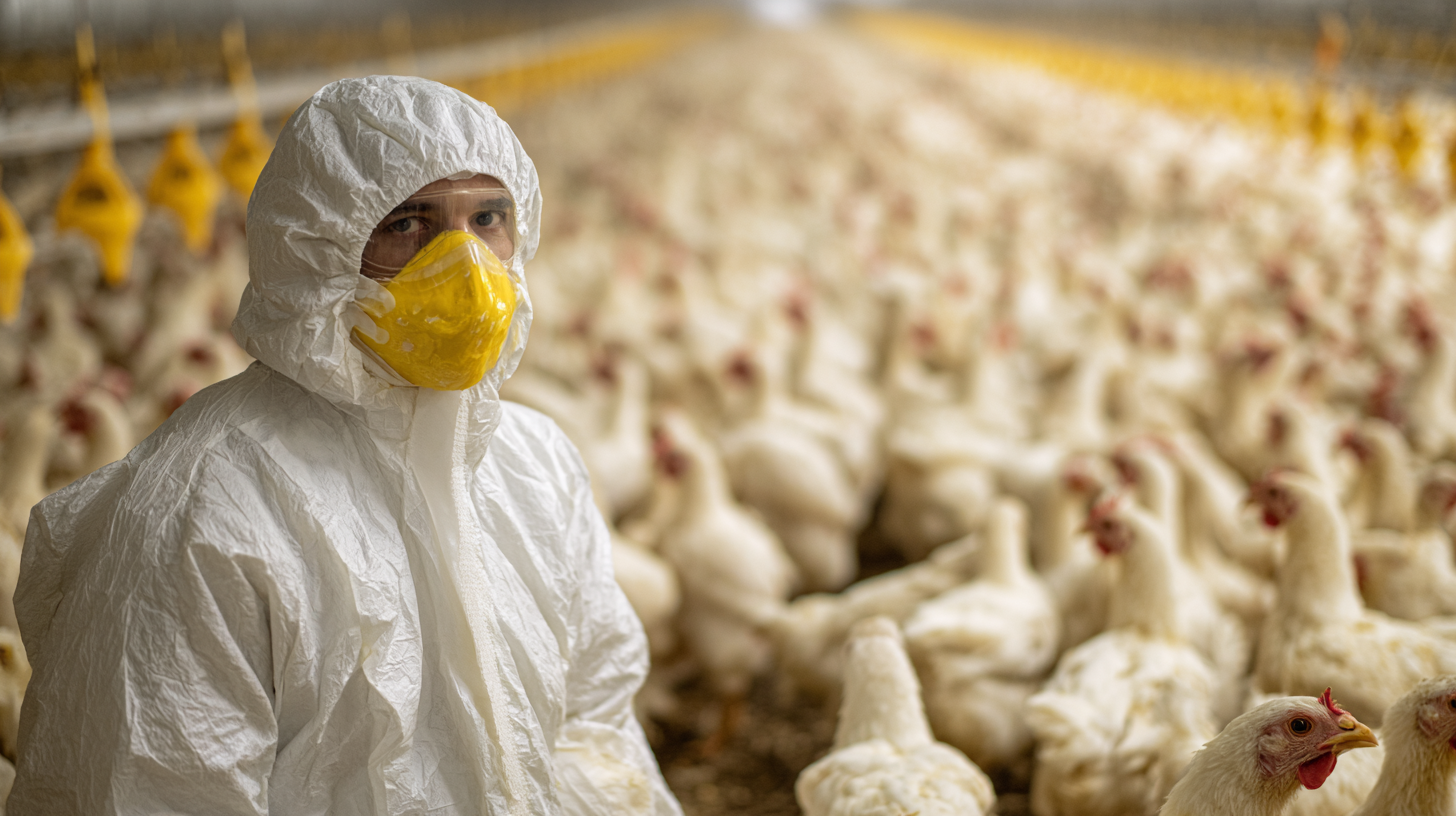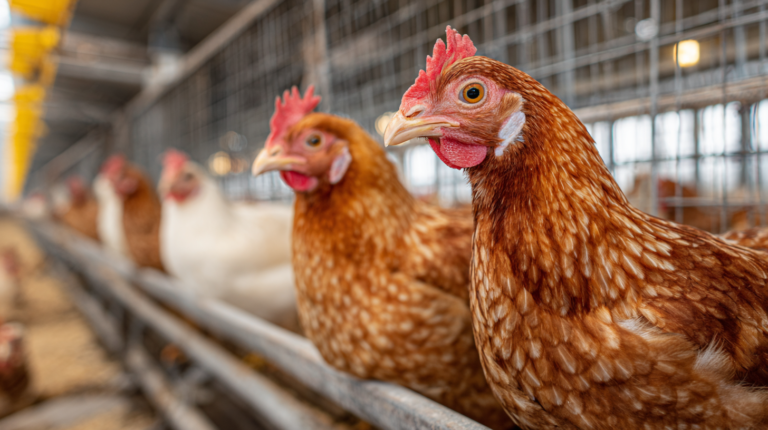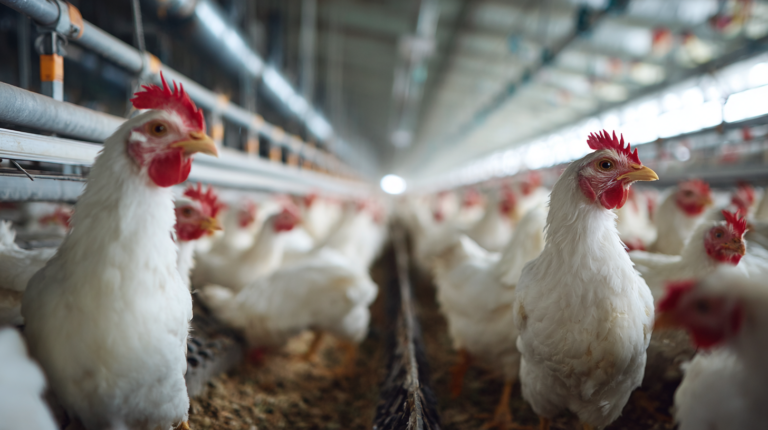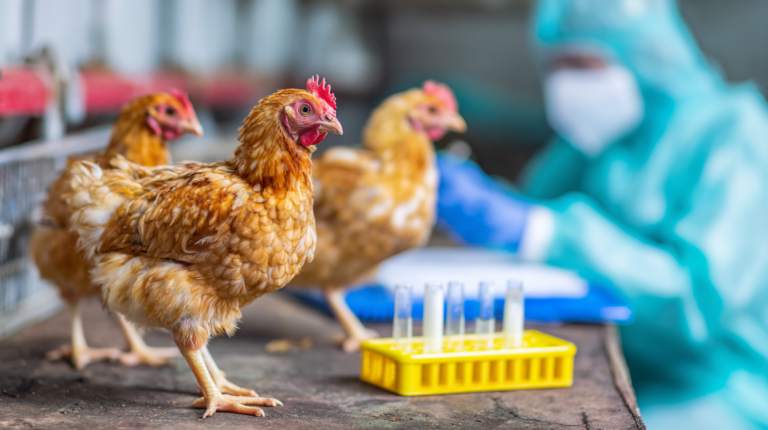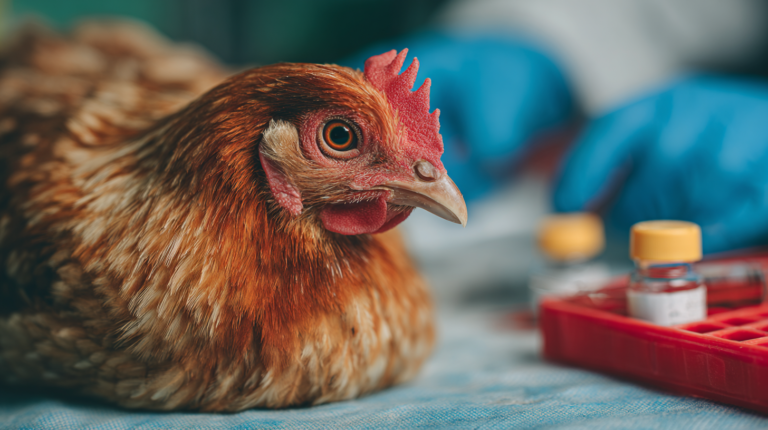Learn the 12 critical warning signs of avian influenza in poultry. Expert veterinary guidance on early detection, prevention, and emergency response to protect your flock.
Table of Contents
The recent surge in avian influenza cases across North America has left poultry owners, small-scale farmers, and backyard chicken enthusiasts on high alert. Avian influenza in poultry represents one of the most significant threats to both domestic birds and the broader agricultural economy, with the potential to devastate entire flocks within days. Understanding the critical warning signs of this highly contagious viral disease could mean the difference between saving your birds and losing them entirely.
Also known as bird flu, avian influenza is a viral infection that affects birds’ respiratory, digestive, and nervous systems. While wild waterfowl typically serve as natural reservoirs for the virus, domestic poultry including chickens, ducks, turkeys, and geese are particularly vulnerable to severe illness and death. The disease spreads rapidly through direct contact with infected birds, contaminated equipment, and even through airborne particles, making early detection absolutely crucial for containment.
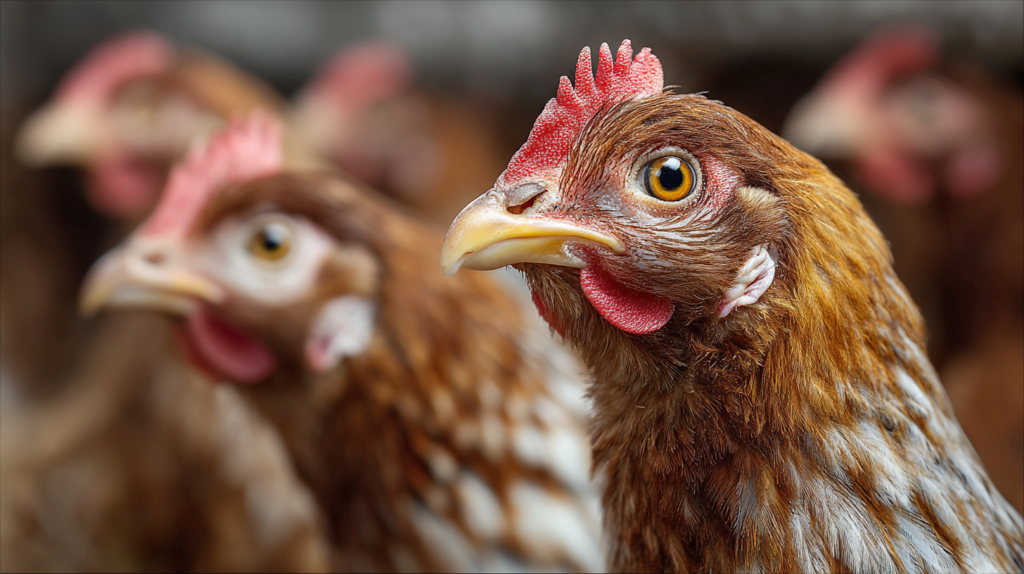
This comprehensive guide will walk you through the twelve most urgent signs of avian influenza in poultry, helping you recognize the symptoms before it’s too late. Whether you’re managing a small backyard flock or overseeing a larger operation, these warning signs could help you take swift action to protect your birds and prevent the spread of this devastating disease.
Understanding Avian Influenza: The Silent Threat to Your Flock
Avian influenza viruses belong to the Orthomyxoviridae family and are classified by two surface proteins: hemagglutinin (H) and neuraminidase (N). The current outbreak is primarily driven by the H5N1 strain, which has shown unprecedented persistence and geographic spread since 2021. According to the United States Department of Agriculture (USDA), more than 82 million birds have been affected by highly pathogenic avian influenza (HPAI) in the United States alone since the current outbreak began.
The virus exists in two main forms: low pathogenic avian influenza (LPAI) and highly pathogenic avian influenza (HPAI). While LPAI typically causes mild symptoms or remains asymptomatic in wild birds, HPAI can kill up to 100% of infected domestic poultry within 48 hours. This stark difference in mortality rates makes understanding the symptoms of avian influenza in poultry essential for anyone raising birds.
Dr. Sarah Mitchell, a veterinary epidemiologist at the National Veterinary Services Laboratory, explains, “The challenge with avian influenza is that initial symptoms can be subtle and easily mistaken for other common poultry diseases. By the time obvious signs appear, the virus has often spread throughout the entire flock.”
The economic impact extends far beyond individual farms. The 2014-2015 outbreak cost the U.S. poultry industry approximately $3.3 billion, while the current outbreak has already exceeded those losses. International trade restrictions, culling requirements, and quarantine measures create ripple effects that impact feed suppliers, processing plants, and consumers worldwide.
The 12 Critical Warning Signs of Avian Influenza in Poultry
| Sign # | Warning Sign | Description | Severity |
|---|---|---|---|
| 1 | Sudden Death | Birds found dead without prior signs of illness | Critical |
| 2 | Respiratory Distress | Gasping, coughing, sneezing, or difficulty breathing | High |
| 3 | Neurological Signs | Tremors, twisted neck, paralysis, or loss of coordination | Critical |
| 4 | Cyanosis | Blue discoloration of comb, wattles, and legs | High |
| 5 | Edema | Swelling of head, neck, and around the eyes | Medium |
| 6 | Decreased Egg Production | Sudden drop in egg laying by 20% or more | Medium |
| 7 | Diarrhea | Watery, greenish, or bloody droppings | Medium |
| 8 | Lethargy | Unusual quietness, depression, or reluctance to move | Medium |
| 9 | Loss of Appetite | Reduced feed consumption or complete anorexia | Medium |
| 10 | Excessive Thirst | Increased water consumption beyond normal levels | Medium |
| 11 | Nasal Discharge | Clear or bloody discharge from nostrils | Medium |
| 12 | Ruffled Feathers | Unkempt appearance with feathers standing away from body | Medium |
1. Sudden Onset of High Mortality Rates
The most alarming indicator of avian influenza in poultry is an unexpected spike in death rates within your flock. Unlike gradual losses from age or chronic diseases, avian influenza can cause multiple birds to die within hours of showing symptoms. Mortality rates can reach 90-100% in chickens and turkeys, while ducks and geese may experience lower but still significant death rates.
Healthy flocks typically experience mortality rates of less than 1% per week under normal circumstances. If you notice 5% or more of your birds dying within a 24-48 hour period, this should trigger immediate concern and veterinary consultation. The rapid progression from apparent health to death is particularly characteristic of HPAI strains.
2. Severe Respiratory Distress and Breathing Difficulties
Respiratory symptoms often appear among the first signs of avian influenza in poultry. Affected birds may exhibit labored breathing, open-mouth breathing, or gasping for air. You might notice birds extending their necks and struggling to breathe, similar to how humans might gasp during severe respiratory illness.
The virus attacks the respiratory system, causing inflammation and fluid accumulation in the lungs and air sacs. This leads to the characteristic wheezing, coughing, and rattling sounds that infected birds make when breathing. Unlike respiratory issues caused by dusty conditions or mild infections, avian influenza-related breathing problems worsen rapidly and don’t respond to environmental changes.
Watch for birds sitting with their beaks open, appearing to pant even in cool weather, or making unusual clicking or gurgling sounds when breathing. These symptoms typically progress from mild to severe within 12-24 hours, making early recognition crucial for potential intervention.
3. Dramatic Reduction in Egg Production
For laying hens, a sudden and severe drop in egg production serves as an early warning sign of avian influenza in poultry. Infected birds may stop laying eggs entirely within 24-48 hours of infection, or production may drop by 50% or more compared to normal levels.
The eggs that are produced may have thin, soft, or misshapen shells, abnormal coloration, or unusual internal consistency. Some eggs may appear completely normal externally but contain blood spots or other internal abnormalities. The virus affects the reproductive system, disrupting normal egg formation and laying patterns.
This symptom is particularly valuable for early detection because it often occurs before other obvious signs appear. Poultry keepers who maintain detailed laying records can quickly identify when production drops below normal parameters, potentially catching infections before widespread mortality occurs.
4. Severe Neurological Symptoms and Behavioral Changes
Avian influenza can cause dramatic neurological symptoms that make infected birds behave abnormally. These signs include lack of coordination, twisted necks, paralysis, tremors, and seizures. Birds may appear disoriented, walk in circles, or be unable to stand or maintain balance.
The neurological effects result from the virus’s ability to cross the blood-brain barrier and directly infect brain tissue. This leads to inflammation and damage to areas controlling movement, coordination, and basic functions. Affected birds may exhibit head tilting, difficulty walking, or complete inability to move normally.
You might observe birds falling over, appearing drunk or unsteady, or displaying repetitive movements. Some birds may become completely paralyzed, while others might show hyperactivity or aggressive behavior that’s completely out of character. These neurological signs often appear alongside respiratory symptoms and typically worsen rapidly.
5. Facial Swelling and Edema
Noticeable swelling around the face, particularly around the eyes, sinuses, and comb, represents another critical sign of avian influenza in poultry. This facial edema can make birds appear to have “puffy” or swollen faces, with eyes that may be partially or completely closed due to surrounding tissue swelling.
The swelling results from inflammation and fluid accumulation in facial tissues as the immune system responds to viral infection. In severe cases, the swelling can be so pronounced that birds cannot open their eyes or may have difficulty eating and drinking due to distorted facial features.
This symptom is particularly obvious in chickens and turkeys, where facial swelling can make the birds appear dramatically different from their normal appearance. The swelling typically develops within 24-48 hours of infection and continues to worsen as the disease progresses.
6. Diarrhea and Digestive System Disruption
Digestive symptoms including severe diarrhea, watery droppings, and changes in normal excrement patterns frequently accompany avian influenza in poultry. The virus affects the gastrointestinal tract, causing inflammation and disrupting normal digestive processes.
Infected birds may produce loose, watery, or bloody droppings that differ significantly from normal feces. The color may change from typical brown or green to yellow, white, or contain blood. Additionally, birds may experience decreased appetite and refuse to eat or drink, leading to rapid weight loss and dehydration.
The digestive disruption can be subtle initially but typically becomes more pronounced as the infection progresses. Birds may also vomit or regurgitate food, though this is less common than diarrhea. The combination of reduced food intake and digestive problems contributes to the rapid decline in infected birds’ condition.
7. Lethargy and Severe Depression
Infected birds often display extreme lethargy and depression, appearing unusually quiet and inactive compared to their normal behavior. This symptom, while subtle, can be among the earliest signs of avian influenza in poultry and may precede more obvious symptoms by several hours.
Affected birds may sit huddled with their heads tucked under their wings, show reluctance to move even when approached, or fail to respond to normal stimuli like feeding time or human presence. The usual social behaviors, vocalizations, and activity levels decrease dramatically as birds become increasingly lethargic.
This behavioral change reflects the systemic nature of the viral infection and its effects on the bird’s overall energy and well-being. Unlike temporary lethargy from minor illnesses or stress, avian influenza-related depression is profound and progressive, worsening rapidly as other symptoms develop.
8. Cyanosis and Circulation Problems
Cyanosis, or bluish discoloration of the comb, wattles, and other exposed skin areas, indicates severe circulation problems associated with avian influenza in poultry. This symptom results from reduced oxygen levels in the blood and poor circulation caused by the virus’s effects on the respiratory and cardiovascular systems.
The normal bright red coloration of combs and wattles may change to dark red, purple, or blue, indicating that the bird’s circulatory system is compromised. In severe cases, the extremities may appear almost black, signaling critical illness and poor prognosis.
This symptom typically appears in conjunction with respiratory distress and indicates that the infection has progressed to a serious stage. Birds showing cyanosis require immediate veterinary attention, though the prognosis for recovery is generally poor once this symptom appears.
9. Excessive Thirst and Drinking Behavior
Infected birds may exhibit increased thirst and drinking behavior, constantly seeking water sources or appearing to drink more frequently than normal. This polydipsia results from fever, dehydration from diarrhea, and the body’s attempt to maintain fluid balance during illness.
You might notice birds spending more time at water sources, drinking for longer periods, or appearing to have an insatiable thirst. Some birds may splash in water or appear to have difficulty swallowing, making drinking attempts less effective.
This symptom, while less dramatic than others, can be an early indicator when combined with other signs. Birds that normally drink moderate amounts of water may suddenly seem constantly thirsty, or water consumption for the entire flock may increase noticeably.
10. Reduced Activity and Social Isolation
Healthy poultry are typically social animals that engage in normal flock behaviors like foraging, dust bathing, and vocalizing. Birds infected with avian influenza often isolate themselves from the flock, preferring to sit alone in corners or away from other birds.
This social withdrawal represents a significant behavioral change, as sick birds instinctively separate themselves from the group. The reduction in normal activities like scratching, pecking, and exploring their environment becomes noticeable to observant caretakers.
Infected birds may also show reduced interest in treats or activities that would normally attract their attention. The combination of physical illness and instinctive isolation behavior makes this symptom particularly telling when evaluating flock health.
11. Unusual Vocalizations or Loss of Voice
Changes in vocalization patterns, including unusual sounds, excessive vocalization, or complete loss of voice, can indicate avian influenza in poultry. The virus affects the respiratory system, potentially causing changes in the vocal apparatus and breathing patterns that alter normal sounds.
Some birds may produce harsh, raspy sounds instead of normal vocalizations, while others may become completely silent. Roosters may lose their ability to crow normally, or their crow may sound strained and weak. Hens may make distressed sounds or unusual calling patterns.
These vocal changes often accompany respiratory symptoms and can be early indicators of infection. The progression from normal vocalizations to abnormal sounds or silence typically occurs within 24-48 hours of infection.
12. Fever and Elevated Body Temperature
While more difficult to detect without direct measurement, fever is a common symptom of avian influenza in poultry. Birds may appear hot to the touch, show increased panting or open-mouth breathing, and display behavioral changes associated with elevated body temperature.
The fever response represents the body’s attempt to fight the viral infection, but it also contributes to the bird’s overall distress and energy depletion. Birds with fever may seek cooler areas, appear restless, or show reduced appetite as their bodies struggle to maintain normal temperature regulation.
Experienced poultry keepers may notice that birds feel warmer than usual when handled, or that they’re seeking shade and cool areas more frequently than normal. This symptom typically accompanies other signs and contributes to the overall decline in the bird’s condition.
Protecting Your Flock from Avian Influenza
| Category | Biosecurity Measure | Implementation Steps | Priority |
|---|---|---|---|
| Access Control | Restricted Entry Points | Establish single entry/exit points, install locked gates, maintain visitor logs, provide protective clothing | Essential |
| Access Control | Footwear Disinfection | Install foot baths with approved disinfectants, change solutions regularly, ensure all visitors comply | Essential |
| Equipment | Dedicated Tools | Use farm-specific equipment only, clean and disinfect between uses, avoid sharing with other operations | Important |
| Equipment | Vehicle Restrictions | Limit vehicle access, disinfect wheels and undercarriage, maintain separate parking areas | Important |
| Housing | Wild Bird Exclusion | Install netting over outdoor areas, seal building gaps, remove food sources that attract wild birds | Essential |
| Housing | Proper Ventilation | Ensure adequate air flow, maintain optimal humidity levels, regular system maintenance and cleaning | Important |
| Hygiene | Hand Sanitization | Provide hand sanitizer stations, enforce handwashing protocols, use approved antimicrobial soaps | Essential |
| Hygiene | Protective Clothing | Provide disposable coveralls, gloves, and masks, proper disposal procedures, regular replacement | Essential |
| Feed & Water | Secure Feed Storage | Store feed in closed containers, protect from wild birds and rodents, regular inspection for contamination | Important |
| Feed & Water | Clean Water Sources | Use municipal or tested well water, clean water systems regularly, prevent wild bird access to water | Recommended |
| Waste Management | Proper Disposal | Secure disposal of dead birds, composting or approved disposal methods, prevent scavenger access | Essential |
| Monitoring | Daily Health Checks | Visual inspection of all birds, record mortality rates, document unusual behaviors or symptoms | Essential |
Prevention remains the most effective approach to managing avian influenza in poultry, as treatment options are limited and often unsuccessful once infection occurs. Implementing comprehensive biosecurity measures can significantly reduce the risk of introducing the virus to your flock.
The foundation of prevention lies in controlling access to your birds and limiting exposure to potential virus sources. This includes restricting visitor access, disinfecting equipment and vehicles, and maintaining separate clothing and footwear for poultry areas. Wild birds represent the primary reservoir for avian influenza viruses, making it crucial to prevent contact between domestic and wild birds.
Physical barriers such as netting, enclosed housing, and proper fencing can help prevent wild birds from accessing feed, water, and living areas used by domestic poultry. Removing attractions like spilled feed, standing water, and nesting sites can discourage wild birds from congregating near your flock.
Regular monitoring and health assessments allow for early detection of problems before they become widespread. Maintaining detailed records of mortality, egg production, feed consumption, and behavioral observations helps identify subtle changes that might indicate disease. Daily visual inspections should include checking for the warning signs outlined in this article.
Proper nutrition and stress management support strong immune systems that can better resist viral infections. Providing balanced nutrition, clean water, adequate space, and appropriate environmental conditions helps maintain overall flock health and resilience.
When to Contact a Veterinarian: Emergency Response Protocol
Recognizing when to seek professional veterinary assistance is crucial for effective avian influenza management. Any sudden increase in mortality, especially when accompanied by respiratory symptoms, neurological signs, or dramatic behavioral changes, warrants immediate veterinary consultation.
The rapid progression of avian influenza in poultry means that delays in professional evaluation can result in total flock loss. Veterinarians can provide definitive diagnosis through laboratory testing, guidance on quarantine measures, and assistance with reporting requirements to animal health authorities.
Contact your veterinarian immediately if you observe multiple birds showing any combination of the twelve warning signs described in this article. Early intervention, while often unable to save infected birds, can help prevent spread to other flocks and assist with proper disposal and disinfection procedures.
Many regions have specific reporting requirements for suspected avian influenza cases. Your veterinarian can guide you through the proper reporting procedures to local and state animal health officials, ensuring compliance with regulations and helping protect the broader poultry population.
Impact on Human Health and Safety Considerations
| Timeframe | Action Required | Details & Procedures | Responsible Party |
|---|---|---|---|
| Immediately (0-2 hours) |
Immediate Isolate Affected Birds |
Separate sick birds from healthy flock, restrict movement, implement emergency biosecurity measures, document symptoms and locations | Farm Owner/Manager |
| Within 4 hours |
Immediate Contact Veterinarian |
Call licensed veterinarian, report symptoms, request emergency visit, prepare for potential quarantine procedures | Farm Owner/Manager |
| 4-8 hours |
Diagnostic Sample Collection |
Collect cloacal and oropharyngeal swabs, blood samples if required, proper labeling and chain of custody documentation | Licensed Veterinarian |
| 8-12 hours |
Diagnostic Laboratory Submission |
Rush samples to approved diagnostic laboratory, complete submission forms, coordinate with animal health authorities | Veterinarian/Lab |
| 12-24 hours |
Containment Voluntary Quarantine |
Implement self-quarantine measures, halt all bird movement, restrict visitor access, enhanced cleaning protocols | Farm Owner/Manager |
| 24-48 hours |
Diagnostic Preliminary Results |
Receive initial diagnostic results, coordinate with state veterinarian if positive, prepare for potential depopulation | Laboratory/State Vet |
| 48-72 hours |
Containment Official Quarantine |
Official quarantine order if positive, coordinate with USDA/state officials, begin depopulation planning if required | State/Federal Officials |
| 3-7 days |
Containment Depopulation Process |
Humane depopulation of affected flocks, proper carcass disposal, environmental sampling, equipment disinfection | Trained Personnel |
| 1-2 weeks |
Containment Cleaning & Disinfection |
Thorough cleaning of all facilities, approved disinfectant application, equipment decontamination, environmental testing | Farm Owner/Contractors |
| 2-4 weeks |
Recovery Facility Monitoring |
Surveillance testing of cleaned facilities, wild bird monitoring, vector control assessment, biosecurity evaluation | State/Federal Officials |
| 4-12 weeks |
Recovery Restocking Preparation |
Final facility approval, enhanced biosecurity implementation, sentinel bird placement, gradual restocking plan | Farm Owner/Veterinarian |
| 3-6 months |
Recovery Full Operation Resume |
Return to normal production levels, ongoing surveillance, lessons learned implementation, business recovery assessment | Farm Owner/Manager |
While avian influenza primarily affects birds, some strains can pose risks to human health, particularly for individuals with direct contact with infected poultry. The current H5N1 strain has caused human infections in rare cases, typically involving people with extensive exposure to infected birds.
Proper personal protective equipment (PPE) including gloves, masks, and protective clothing should be used when handling sick birds or cleaning areas where infected poultry have been housed. Hand washing and sanitization after any contact with birds or their environment represents a basic but essential safety measure.
Individuals with compromised immune systems, pregnant women, and young children should avoid contact with sick birds and areas where avian influenza is suspected. If exposure occurs, monitoring for flu-like symptoms and seeking medical attention if symptoms develop is recommended.
The risk to the general public remains low, as avian influenza does not typically spread easily between humans. However, maintaining awareness of proper safety practices and following guidance from health authorities helps protect both individual and public health.
Economic Implications and Recovery Strategies
The economic impact of avian influenza extends far beyond the immediate cost of lost birds. Quarantine measures, testing requirements, disposal costs, and facility disinfection can create significant financial burdens for poultry operations of all sizes.
Recovery from an avian influenza outbreak requires comprehensive planning and often involves complete depopulation and extended downtime before restocking can occur. The virus can persist in the environment for extended periods, particularly in organic matter and cooler temperatures, necessitating thorough cleaning and disinfection protocols.
Insurance coverage for avian influenza varies significantly, and many policies exclude coverage for viral diseases or require specific biosecurity measures to maintain coverage. Understanding your insurance policy terms and maintaining proper documentation can be crucial for potential claims.
Government assistance programs may be available to help offset losses from avian influenza outbreaks, particularly for commercial operations. The USDA Animal and Plant Health Inspection Service (APHIS) provides indemnity payments for birds that must be destroyed due to avian influenza, though compensation levels may not cover all associated costs.
Research and Future Developments
Ongoing research into avian influenza focuses on developing better vaccines, improving diagnostic methods, and understanding viral evolution and transmission patterns. Current vaccines for poultry have shown mixed results and may interfere with surveillance programs, limiting their practical application.
Scientists are investigating novel approaches including genetically modified birds with enhanced resistance to avian influenza, improved biosecurity technologies, and rapid diagnostic tools that could enable faster response to outbreaks. These developments hold promise for better management of future outbreaks.
International cooperation in surveillance and research is crucial for understanding global patterns of avian influenza and developing effective response strategies. The interconnected nature of modern poultry production and international trade makes collaborative efforts essential for controlling this disease.
Climate change may influence avian influenza patterns by affecting wild bird migration routes, breeding patterns, and virus survival in the environment. Understanding these connections helps inform long-term prevention and management strategies.
Frequently Asked Questions
Everything you need to know about Avian Influenza in Poultry
Avian influenza can spread through a flock within 24-48 hours under optimal conditions for the virus. The highly contagious nature of the virus means that once one bird is infected, the entire flock is at risk. Factors such as housing density, ventilation, and biosecurity measures can influence the rate of spread.
No, avian influenza is a viral infection and cannot be treated with antibiotics, which only work against bacterial infections. Currently, there are no approved antiviral treatments for avian influenza in poultry. Prevention through biosecurity measures remains the most effective approach.
The virus can survive in the environment for varying periods depending on temperature, humidity, and organic matter presence. In cool, moist conditions, the virus may persist for weeks or months, while hot, dry conditions typically reduce survival time to days or weeks.
While backyard flocks may have different risk factors, they are not necessarily at lower risk than commercial operations. Wild bird contact, inadequate biosecurity, and mixing of different bird species can actually increase risk in some backyard settings. Proper biosecurity is essential regardless of flock size.
Eggs from birds suspected of having avian influenza should not be consumed and should be disposed of according to local animal health authority guidelines. The virus can potentially be present in eggs from infected birds, making proper disposal essential for preventing further spread.
While avian influenza primarily affects birds, some mammalian species can become infected, particularly those with close contact to infected birds. Dogs, cats, and other mammals have been infected in rare cases, though transmission between mammals is uncommon.
No questions found matching your search. Try different keywords or browse all questions above.
For more expert pet care tips and product recommendations, visit BlithePet.com — your trusted source for pet wellness.
Conclusion: Vigilance Saves Lives
Avian influenza in poultry represents a serious threat that requires constant vigilance and immediate action when symptoms appear. The twelve warning signs outlined in this comprehensive guide provide poultry keepers with the knowledge necessary to recognize this devastating disease before it’s too late.
Early detection remains the key to minimizing losses and preventing spread to other flocks. By understanding these critical symptoms and implementing proper biosecurity measures, poultry keepers can protect their birds and contribute to broader efforts to control avian influenza outbreaks.
Remember that prevention through biosecurity is always more effective than treatment after infection occurs. Regular monitoring, proper hygiene, and limiting exposure to wild birds form the foundation of effective avian influenza prevention. When in doubt, consult with a veterinarian immediately, as the rapid progression of this disease leaves no room for hesitation.
The economic and emotional impact of losing an entire flock to avian influenza can be devastating, but with proper knowledge and preparation, poultry keepers can significantly reduce their risk and protect their investments. Stay informed about current outbreak patterns in your area and maintain the highest standards of biosecurity to keep your birds safe.
Have a similar experience with your pet? Share it in the comments below!

